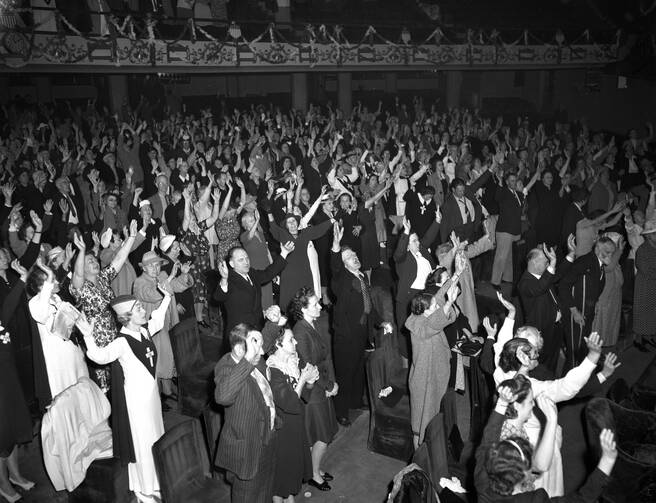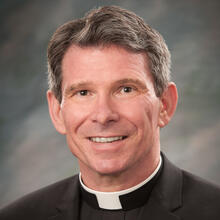A Homily for the Solemnity of the Ascension
Readings: Acts 1:1-11, Ephesians 1:17-23, Luke 24:46-53
Who built the first megachurch in the United States? The most famous evangelist of the 1920s, a Canadian born faith healer named Aimee Semple McPherson. Twice married and with two children, thirty-three-year-old Aimee was both a widow and a divorcée when she opened the Angelus Temple in 1923.
Los Angeles called the neoclassical, Colosseum-like building “the Million Dollar Temple,” though it had cost considerably less. Aimee was also the first woman granted an American radio license, when she launched KFSG. At the time, Kall Four Square Gospel Radio was one of only three stations in Los Angeles.
If you have ever wondered why we celebrate the Ascension of Jesus, his departure from us, consider this scene, earlier in Aimee’s career, when she was preaching a 1920 revival in Dayton, Ohio. It comes from Sister, Sinner: The Miraculous Life and Mysterious Disappearance of Aimee Semple McPherson by Claire Hoffman (2025).
The first morning of the services, a limousine lent by the local pastor took Aimee from her hotel to the hall. The route was thick with ambulances, trolleys, buses, cars, and hearses, all of which contained people in search of a miraculous transformation. From the car window, Aimee saw bodies splayed out on cots and stretchers being carried in. The mass of suffering overwhelmed her. “Oh God,” she whispered, “is the whole world sick? Are they all coming to Memorial Hall to Thee for healing?”
As the limousine inched toward the back entrance, followers pressed against the car. “Oh lady! Pray for me. Oh!” they shouted. “Lay your hands on this man and pray for just a moment.” It was a chorus of anguish and misery, people desperate for miracles. “We have brought this child forty miles, surely you can let us in.”
As she exited the car, police officers linked arms and formed a pathway for Aimee to walk through the crowd. She dashed toward the entrance, seeing people in a blur, but she noticed that the officers’ faces were close to tears with pain as the anguished throng threw themselves against their backs, trying to get to her. The door slammed behind her, but she could still hear the moans.
Aimee made her way toward the stairwell. There, she looked down into the basement and saw a horde of people in wheelchairs and on gurneys.
Could Jesus’ first days after his resurrection have been described in similar terms had he simply chosen to resume his ministry? Without the Ascension, would Jesus still be making his way around the globe, preaching his own Gospel?
Consider the theological implications of such a counterfactual scenario. Centuries of guaranteed healings would certainly silence skeptics, but they would do much more than that. They would remove our freedom to respond to God.
A God who made himself so manifest would still be God, but we would no longer be human. Such healings would be like sunshine and rain. They would be perennial features of life, which we would not choose. Consequently, they would make no claim upon our freedom. They would not summon us, seek out our acceptance. Instead, we would be forced to respond, even submit, to such an omnipresent deity. That alternative scenario was closed at the Ascension.
Following the sequence of the Scriptures, we distinguish three actions of God as distinct events: the resurrection, the Ascension and the bestowal of the Holy Spirit. Hence our three separate feasts of Easter, Ascension and Pentecost. But the initial experiences of the nascent church were probably more conjoined, more continuous.
In the resurrection of Jesus from the dead, God gave the final and ultimate vindication of Jesus’ ministry. In his Ascension, the humanity that Jesus assumed for our wooing, the bridegroom he had become, entered the very life of the Trinity, thus revealing the destiny of those who embrace him and follow where he leads. All of this is the work of the Holy Spirit, who remains with us in the world.
For many people, Christ only exists as a notion, one they either favor, disfavor or ignore. But even when he becomes more than that, when we personally encounter him, Jesus enters our lives in a thoroughly human way. He is one of many lovers who present themselves to us. We are given signs of his love, spiritual and physical, but they do not compel our love, for true love cannot be coerced.
Jesus healed the sick. He even raised the dead, but he did not come among us simply to remove illness and life’s burdens. His mission was not to heal and then reinsert us into the same earthly lives. What happened to Lazarus and to all those whom Jesus healed was a great sign of what was to come, not a terminus.
No, Christ came to woo us, to betroth himself to us, to carry us with him back to the bosom of the Father. What happened in the ministry of Jesus and continues in our Spirit-led lives today is part of a much larger pattern.
Brothers and sisters, since through the blood of Jesus
we have confidence of entrance into the sanctuary
by the new and living way he opened for us through the veil,
that is, his flesh (Heb 10:19-20).
Aimee Semple McPherson’s life of ministry veered into repeated scandal. That does not prove that she had never been a channel of God’s grace. It does suggest that all flesh under the wound of sin is confined, constrained and destined to pass away. Unlike her Lord, Aimee was not a perfect expression of God’s presence, God’s love. None of us are.
Christ’s ministry among us passed through scandal and death into the very presence of the Father. Now his ministry is the work of the Spirit. We have been clothed “with power from on high” (Lk 24:49). The Spirit is the very strength of the savior’s love, he who desires that “where I am they also may be” (Jn 17:24).








